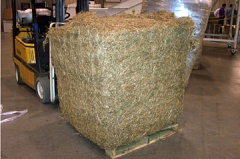Flax
| Infobox on Flax | |
|---|---|
| Example of Flax |  |
| Facts | |
| Origin | - |
| Stowage factor (in m3/t) | 2,8/3,8 m3/t (bales, depending on origin) |
| Humidity / moisture | See text |
| Ventilation | See text |
| Risk factors | See text |
Flax
Description / Application
Flax is an erect annual plant growing to 1.2 m tall, with slender stems. The leaves are glaucous green, slender lanceolate, 20–40 mm long and 3 mm broad. The flowers are pure pale blue, 15–25 mm diameter, with five petals; they can also be bright red. The fruit is a round, dry capsule 5–9 mm diameter, containing several glossy brown seeds shaped like an apple pip, 4–7 mm long.
In addition to referring to the plant itself, the word "flax" may refer to the unspun fibers of the flax plant.
Flax is grown for its use as an edible oil, as a nutritional supplement, and as an ingredient in many wood finishing products. Flax is also grown as an ornamental plant in gardens. Flax fibers are used to make linen; the coarse fibers in the manufacture of canvas.
Flax seeds come in two basic varieties: (1) brown; and (2) yellow or golden. Most types have similar nutritional characteristics and equal numbers of short-chain omega-3 fatty acids. The exception is a type of yellow flax called solin (trade name Linola), which has a completely different oil profile and is very low in omega-3 FAs. Although brown flax can be consumed as readily as yellow, and has been for thousands of years, it is better known as an ingredient in paints, fiber and cattle feed. Flax seeds produce a vegetable oil known as flaxseed or linseed oil, which is one of the oldest commercial oils, and solvent-processed flax seed oil has been used for centuries as a drying oil in painting and varnishing.
Flax seed sprouts are edible, with a slightly spicy flavour. Excessive consumption of flax seeds with inadequate water can cause bowel obstruction. Flaxseed, called ('Tisi' or 'Alsi') in northern India, has been roasted, powdered and eaten with boiled rice, a little water, and a little salt since ancient times in the villages.
Whole flax seeds are chemically stable, but ground flaxseed can go rancid at room temperature in as little as one week. Refrigeration and storage in sealed containers will keep ground flax from becoming rancid for a longer period; under conditions similar to those found in commercial bakeries, trained sensory panelists could not detect differences between bread made with freshly ground flax and bread made with milled flax stored for four months at room temperature. Milled flax is remarkably stable to oxidation when stored for nine months at room temperature if packed immediately without exposure to air and light and for 20 months at ambient temperatures under warehouse conditions.
Three natural phenolic glucosides, secoisolariciresinol diglucoside, p-coumaric acid glucoside and ferulic acid glucoside, can be found in commercial breads containing flaxseed.
Flax fiber is extracted from the bast or skin of the stem of the flax plant. Flax fiber is soft, lustrous and flexible; bundles of fiber have the appearance of blonde hair, hence the description "flaxen". It is stronger than cotton fiber but less elastic. The best grades are used for linen fabrics such as damasks, lace and sheeting. Coarser grades are used for the manufacturing of twine and rope. Flax fiber is also a raw material for the high-quality paper industry for the use of printed banknotes and rolling paper for cigarettes and tea bags. New methods of processing flax and the rising price of cotton have led to renewed interest in the use of flax as an industrial fiber.
Shipment / Storage
Flax is a soft fiber usually shipped in 100 kg. press-packed bales, inside freight containers.
Recognized moisture regain from bone-dry 12% by weight but slightly variable according to atmospheric conditions.
Damage by water, fire, smoke or heat is serious and recovery value minimal if any. This will cause considerable weakening of the fibers. If loaded wet may lead to heating. Should be well ventilated; air exchange rate: 10 changes/hour (airing). Moisture must constantly be eliminated, to reduce mould and bacterial activity.
In damp weather (rain, snow), the cargo must be protected from moisture, since flax is strongly hygroscopic and readily absorbs moisture. This may lead to discoloration, decay, staining, a musty odor and rusted steel strapping.
Stow cool, dry.
Risk factors
- Self heating; flax is assigned to Class 4.1 of the IMDG Code (Flammable solids). However, its specific characteristics and negative external influences may cause it to behave like a substance from Class 4.2 (Substances liable to spontaneous combustion) of the IMDG Code or ADR.
- Odour
- Contamination
- Mechanical influences
- Insect infestation / Diseases
- Spontaneously combustible
Note: Check the IMDG (International Maritime Dangerous Goods) Code for overseas transport information.











